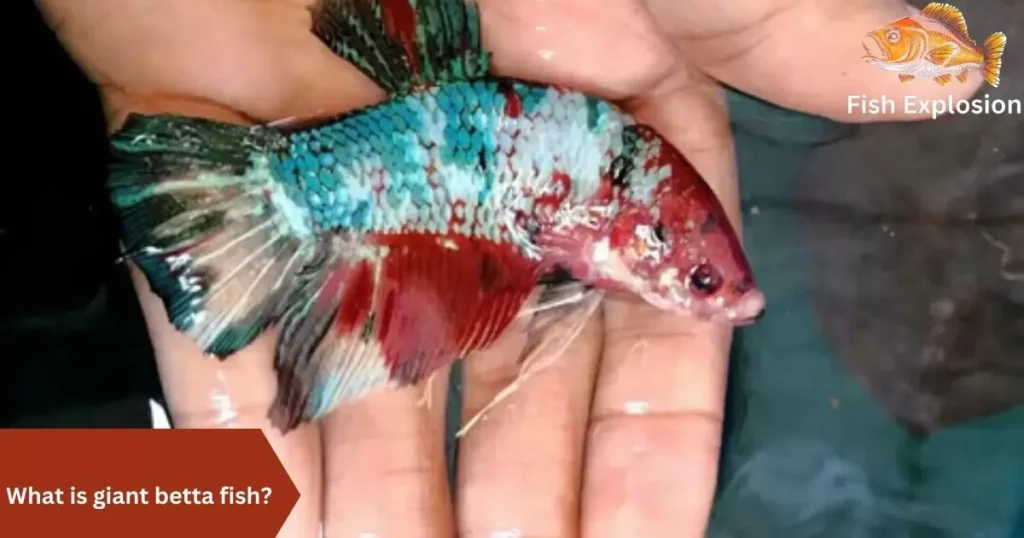Giant betta fish, also known as king betta or halfmoon betta, are a larger variety of the popular Siamese fighting fish.
They can grow up to 6 inches long, which is significantly larger than the common betta, which typically measures 2-3 inches. Giant bettas require larger aquarium accommodations, with at least a 10-gallon tank recommended for a single fish. These magnificent bettas display exaggerated finnage with flowing tails and broad pectoral fins, making them a stunning addition to the aquarium.
Like their smaller counterparts, giant bettas are labyrinth fish that can breathe air from the surface, but they still need excellent water quality and warm temperatures around 78-82°F. Their aggressive nature means they must be housed alone or with very carefully selected tankmates.
Overview
The giant betta, scientifically known as Betta splendens, is a selectively bred variety of the popular Siamese fighting fish. These bettas have been bred over many generations to accentuate their size, flowing fins, and vibrant coloration.
While standard bettas max out around 3 inches, giants can reach an impressive 6 inches in length. Their magnificent appearance is characterized by extravagant fins and tails that billow elegantly as they swim. Giant bettas come in a kaleidoscope of colors, from vibrant blues and reds to more subdued pastels.
Though larger than typical bettas, they have similar environmental and care needs – requiring a heated, cycled aquarium with excellent water conditions. Their bigger size means they need roomier housing, with at least a 10-gallon aquarium recommended for these beautiful fish.
What is giant betta fish?

A giant betta fish is a variety of the popular Siamese fighting fish (Betta splendens) that has been selectively bred over many generations to grow much larger than the common betta. While a normal betta typically only reaches 2-3 inches in length, giant bettas can grow up to an impressive 6 inches long.
They have the same brilliant coloration and flowing fins and tails that regular bettas are known for, but their size and fin lengths are exaggerated. Giant bettas require more space than their smaller counterparts, with at least a 10-gallon aquarium recommended to accommodate their larger size.
Despite their name, they have the same underwater breathing labyrinth organ as other betta species and the same general care requirements in terms of warm temperatures, excellent water quality, and potential for aggression towards other bettas.
Their magnificent size and fin displays make giant bettas a showstopping addition to the freshwater aquarium.
Origin and habitat
Origin
The origins of giant betta fish can be traced back to the selective breeding efforts of betta enthusiasts, most notably in Thailand and other parts of Southeast Asia. Over many generations, breeders focused on developing larger, more exaggerated fin types and sizes compared to the typical Siamese fighting fish.
By carefully choosing and breeding only the largest, most vividly colored specimens with the most extreme fin lengths and shapes, they were able to create distinct strains that we now know as king bettas or giant bettas.
This labor-intensive breeding process has resulted in some of the most magnificent ornamental betta varieties prized by aquarium hobbyists worldwide.
Habitat
In their natural habitat, the giant betta’s ancestors are found in the shallow, sluggish moving waters across the Mekong basin of Thailand, Cambodia, Laos, Vietnam, and other parts of Southeast Asia.
They thrive in vegetated marshes, rice paddies, and flood plains that allow them easy access to the water’s surface to breathe air with their specialized labyrinth organ. Their ideal aquatic environment has plenty of planted areas to claim as a territory and take shelter among the aquatic vegetation.
Though domesticated giants may be far removed from their wild counterparts, providing ample plant cover and a heated, cycled aquarium best replicates their preferred habitat conditions. Meeting their environmental needs is key to keeping these spectacular bettas healthy and vibrant.
Giant betta fish appearance
The giant betta fish is a true showstopper when it comes to appearance. These selectively bred bettas flaunt enormously exaggerated finnage compared to regular Siamese fighting fish. Their flowing fins and tails can extend several times the length of their body, billowing elegantly as they swim.
The most striking giant betta varieties are the halfmoon and overhalfsoon types, with caudal fins that form a full 180-degree spread. Their pectoral fins are also enlarged, fanning out in a curved crescent shape. Giant bettas come in virtually every color – from vibrant royal blues to fiery reds to shimmering opaline white.
Their scales have an irridescent metallic sheen, and many exhibit intricate patterns or multicolored patchwork. With their grand size reaching up to 6 inches, giant bettas cut an unmistakable figure as the kings of the aquarium.
Male and Female
When it comes to giant bettas, there are distinct differences between males and females in terms of appearance and behavior. Male giants are significantly larger, more vibrantly colored, and exhibit the dramatic, flowing fins and tail that the variety is known for. Their fins can extend twice the length of their body or more.
Females, by contrast, remain more modest in size, around 4 inches and have shorter, tighter fins lacking the male’s exaggeration. While females can still be brightly colored, their fins tend to be opaque rather than the iridescent sheen of males.
Behaviorally, male giants are extremely territorial and should never be housed together as they will fight viciously. Females make better community tank residents as they are not as aggressive, though potential tankmates still need to be chosen carefully. When breeding, the male builds a spectacular bubble nest before embracing the female.
Size
The defining characteristic of the giant betta variety is their massive size compared to regular Siamese fighting fish. While common bettas typically only reach 2-3 inches in length, giants have been selectively bred over many generations to grow substantially larger.
A mature male giant betta can attain an impressive length of 5-6 inches from head to tail tip. Some exceptional specimens may even be 7 inches long! Females, though smaller than their male counterparts, still dwarf the size of a normal betta at around 4 inches.
The giants’ size is further amplified by their hugely exaggerated finnage and flowing tails, which create an even larger visual presence in the aquarium. To accommodate their larger proportions, giant bettas require more generous housing, with at least a 10-gallon tank recommended as the minimum to provide adequate swimming space and territory for the territorial male fish. Their grand dimensions make them a true showpiece in the freshwater aquarium.
What is difference between giant betta fish and regular betta fish?
Giant bettas and regular bettas exhibit numerous distinctions in terms of size, appearance, temperament, and care requirements. Below are key points of differentiation:
Size: The giant betta variety dwarfs the regular Siamese fighting fish in proportions. Giants can attain lengths of 5-6 inches, with some reaching up to an impressive 7 inches, while regular bettas typically only grow to 2-3 inches long.
Appearance: Contrasting with the long, flowing fins of regular bettas, giant bettas showcase shorter, thicker fin types more akin to the plakat style. However, their fins and tails are still dramatically exaggerated compared to normal bettas. Both varieties offer a kaleidoscope of vibrant colors, though giants often exhibit even more intense, metallic shades.
Temperament: Like their smaller counterparts, giant bettas are highly territorial and should not be housed together, as they will fight aggressively. However, their much larger size makes giants an even bigger threat to smaller tankmates that may appear to encroach on their territory. Giants also tend to be less tolerant of disruptions from other fish due to their heightened aggression.
Care Requirements: To accommodate their impressive size, giant bettas require substantially larger housing than regular bettas, with a minimum 10-gallon tank recommended for a single specimen. Their larger appetites mean they need much more food compared to regular bettas to sustain their fast growth and higher activity levels. Generous swimming space and hiding spots are also essential for these magnificent fish.
Breeding giant betta fish
Breeding giant betta fish presents a challenging endeavor requiring meticulous preparation. Adequate readiness is paramount prior to initiation. Below are key steps essential for successfully breeding giant betta fish:
Select the Pair
Look for vibrantly colored male and female betta fish over 5 inches. Ensure they are healthy and the tank is properly cycled before breeding. Pick fish from differing genetic lines to avoid inbreeding.
Prepare the tank
Condition a large tank of 20 gallons or more with live plants, hiding spots and a sponge filter. Raise the water temperature to 80-82°F for breeding. Perform regular water changes.
Introduce betta fish
Place the female in first to establish her territory. Add the male and observe their interaction. If no signs of stress occur, they are ready to breed. Remove either Betta who displays aggressiveness.
Mating
The male will flare his fins and chase the female until she is ready. She will release her eggs, which he will then fertilize. Remove the female afterwards to avoid injury.
Post-mating
The male will guard and aerate the eggs stuck to plants. In 5-7 days, fry will hatch and absorb their yolk sacs. The male may eat eggs if they are not removed by day 7.
Fry care
Transfer fry to a grow-out tank with gentle water flow and feed them infusoria or commercial fry foods. As they grow, perform partial water changes and increase feeding amounts. Within 4-6 months, fry will reach maturity.
Care guide for giant betta Fish
An effective care guide for giant betta fish must address several critical areas. Proper housing is vital – they need spacious aquariums of 20 gallons or more with subtle decoration to reduce stress.
Water quality also demands close monitoring given their bioload; frequent partial water changes keep parameters ideal. In addition to their regular diet of high protein flakes and pellets, giant bettas appreciate supplements like brine shrimp and bloodworms to thrive.
Lastly, maintaining comfortable temperatures between 78-82 degrees through balanced filtration and lighting completes their basic needs for excellent health and color.
Tank set up
Setting up the tank correctly is an important first step for keeping giant betta fish. The tank should be at least 20 gallons long and provide ample swimming space. Live plants like anubias, java ferns, and mosses should be attached to driftwood, rocks, or the background to add security and oxygen to the water. Bettas feel most secure in shallow tanks, so limiting the water depth is preferable.
A quality filter designed not to have too much flow and a gentle heater are also essential pieces of equipment. Finally, decor pieces like terracotta pots or slate caves offer hiding spots for the giant betta to rest. With a properly structured environment, optimized water parameters, and minimal visual disturbance, the fish can thrive and display its natural splendor.
Filter
A filter is crucial for housing giant betta fish to keep water conditions optimal. As these fish produce more waste than smaller varieties, filtration helps eliminate toxins before they become harmful. An adjustable flow filter that won’t stress the betta is best.
Sponge filters provide biological filtration without strong currents. Place the filter intake in a low-flow area and baffle it if needed. Proper filtration ensures giant bettas stay active and healthy.
Heating
Giant bettas are tropical fish that require warm water to thrive. A fully submersible aquarium heater maintains temperatures within the 78-82°F range they find comfortable. Position the heater opposite the filter outlet to promote temperature consistency.
Heaters with automatic shut-off prevent overheating mishaps. Daily thermometer checks keep the giant betta living at the temperature best suited for metabolism, immunity, and coloration.
Food and diet
Giant bettas have high protein needs to power their large frames. Feed them a varied diet incorporating quality flakes or pellets, as well as supplements twice daily. They particularly relish nutritionally rich and frozen foods like bloodworms, brine shrimp, and daphnia.
Avoid overfeeding, which pollutes water parameters. Fasting 1-2 days weekly and enjoying mealworm flavorers adds variety. With the right nourishment, these magnificent fish attain their full splendor and longevity.
Where to Buy Giant Betta Fish
There are a few good options for purchasing giant betta fish. Local fish stores sometimes carry them. Ask if any are expected to come in stock soon. Online breeders usually have the best selection and prices. Research their reputation beforehand.
Giant Betta Society members often sell quality fish. Contact hobbyists you find through aquarium clubs too. Mail orders take 1-2 days for delivery. Make sure the bag is cold and has an oxygen pack.
The vibrant new betta will then be ready for its spacious luxury home. Proper acclimation prevents illness from shipping stress. With research and patience, the perfect specimen can be found.
FAQ’s
How do you take care of a giant betta fish?
Proper water conditions, a varied diet, and a spacious heated tank are keys to caring for giant bettas.
How big of a tank do giant bettas need?
Giant bettas need a minimum tank size of 20 gallons due to their large size and bioload.
What makes a betta a giant?
Bettas over 5 inches in length or body mass are considered giants due to their notably larger size than standard varieties.
What is the best tank for a giant betta?
The best tank for a giant betta is a long 20-30 gallon aquarium that provides plenty of swimming space and hides.
Conclusion
In conclusion, giant bettas make fascinating and impressive aquarium pets but require dedicated care. Their large size means higher water quality demands than average bettas. With a stable environment, ample swimming space, a varied nutrient-dense diet, and watchful husbandry, these stately fish can thrive for years, growing to reach sizes over 8 inches.
For dedicated fishkeepers, the rewards of owning giant bettas include witnessing their striking coloring and fins flourish alongside distinctive personalities. While a greater commitment, their presence elevates any aquascaped home.
Through gaining comprehensive knowledge of their specific needs addressed above, along with an accommodating large aquarium setup, giant bettas may seem challenging but prove tremendously fulfilling companions. Their majestic forms deserve an enriched, tailored habitat befitting their stature as magnified aquarium royalty when cared for properly.
With three years of dedicated expertise in the niche of fish, my domain knowledge encompasses breeding, habitat maintenance, health management, and sustainable aquaculture practices, ensuring optimal outcomes in the aquatic realm.











